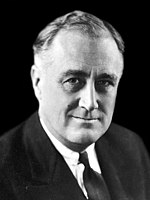| |||||||||||||||||||||||||||||
| Turnout | 72.6%[1] | ||||||||||||||||||||||||||||
|---|---|---|---|---|---|---|---|---|---|---|---|---|---|---|---|---|---|---|---|---|---|---|---|---|---|---|---|---|---|
| |||||||||||||||||||||||||||||
 County Results
| |||||||||||||||||||||||||||||
| |||||||||||||||||||||||||||||
| Elections in New York State |
|---|
 |
The 1936 United States presidential election in New York took place on November 3, 1936. All contemporary 48 states were part of the 1936 United States presidential election. Voters chose 47 electors to the Electoral College, which selected the president and vice president. New York was won by incumbent Democratic President Franklin D. Roosevelt of New York, who was running against Republican Governor of Kansas Alf Landon. Roosevelt ran with incumbent Vice President John Nance Garner of Texas, and Landon ran with newspaper publisher Frank Knox of Illinois.
A former Governor of New York who had easily carried the state four years earlier, Franklin Roosevelt won New York State in 1936 by an even more decisive margin. Roosevelt took 58.85% of the vote versus Alf Landon's 38.97%, a margin of 19.88%. Despite being Roosevelt's home state, in the context of the 1936 nationwide Democratic landslide, New York weighed in for this election as 4% more Republican than the national average,[2] although FDR won the state by nearly 20 points.
Roosevelt won his home state by means of a dominance of the massively populated New York City area, performing even more strongly than he had in 1932. Roosevelt took over 70% of the vote in the boroughs of Manhattan, Brooklyn and the Bronx, and took over 60% of the vote in Queens and Staten Island. For the era, this was an historically overwhelming victory for a Democratic presidential candidate in the five boroughs of New York City, and enough to easily secure a statewide win for Roosevelt. The emergence of the New Deal Coalition was at its peak in 1936,[3] and made American cities with their powerful political machines core bases of support for the Democratic Party.[4] The Great Depression had accelerated the process of urbanization of the Democratic Party which had begun with the election of 1928. Roosevelt's landslide win in New York City was a fruit born by this process, and over the whole nation, he achieved majorities in the largest cities totaling twice what Harding had achieved in 1920.[5] FDR's 1936 victory in New York State would also be the strongest statewide Democratic performance ever in terms of both margin and vote share until 1964.[2]
- ^ Bicentennial Edition: Historical Statistics of the United States, Colonial Times to 1970, part 2, p. 1072.
- ^ a b Counting the Votes; New York
- ^ Davin, Eric Leif; Crucible of Freedom: Workers' Democracy in the Industrial Heartland, 1914–1960, p. 268 ISBN 0739122398
- ^ Prologue: The Journal of the National Archives (1979), p. 114
- ^ Heale, Michael; The United States in the Long Twentieth Century: Politics and Society since 1900, p. 77 ISBN 1472511565
© MMXXIII Rich X Search. We shall prevail. All rights reserved. Rich X Search


